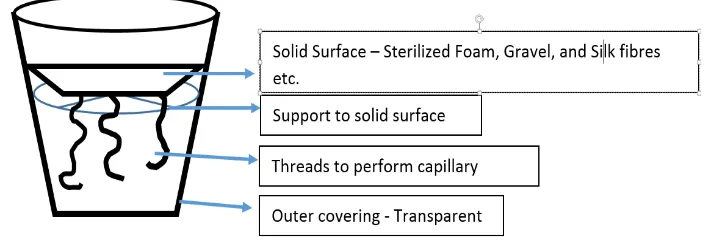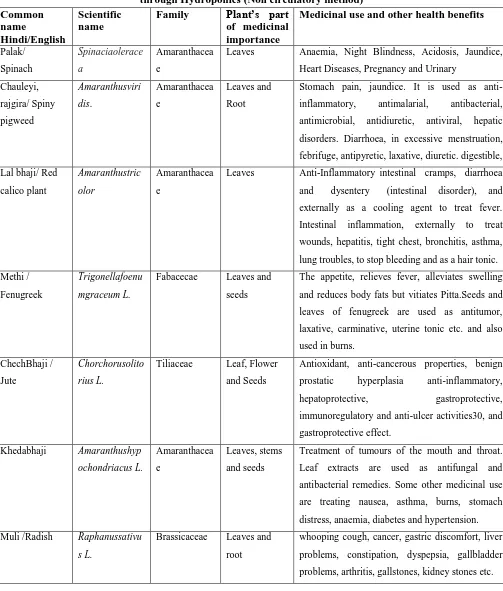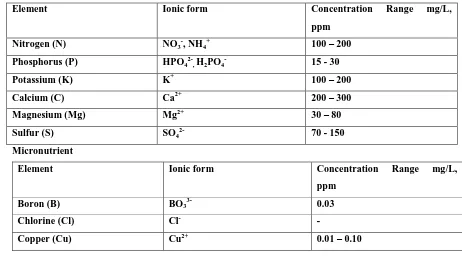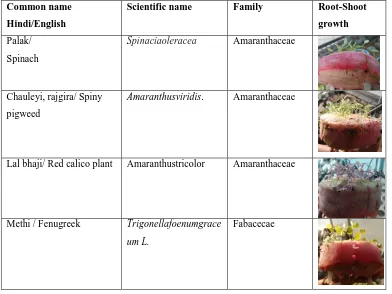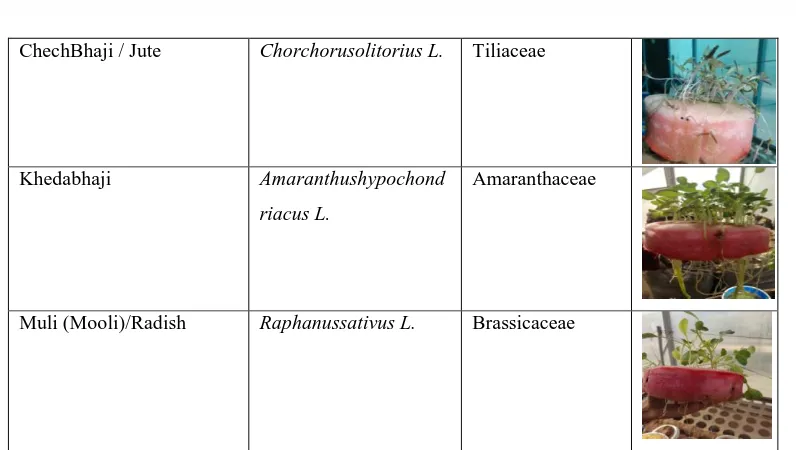1395 | P a g e
STUDY ON PRACTICABILITY OF HYDROPONICAL
CULTURE WITH SOME LEAFY VEGETABLES
KNOWN FOR MEDICINAL PROPERTIES IN
CHHATTISGARH - INDIA
1
Labya Prabhas,
2Megha Agrawal,
3Kamlesh Shukla
1
Assistant Professor, School of Life Sciences,
Pt. Ravishankar Shukla University, Raipur ,C.G. (India).
2
Assistant Professor, Department of Botany,
Gurukul Mahila Mahavidyalaya, Kalibadi Road, Raipur, C.G. (India).
3
Assistant Professor, School of Studies in Biotechnology,
Pt. Ravishankar Shukla University, Raipur, C.G (India).
ABSTRACT
Soilless plant culture technique known as “Hydoponics” is used to cultivate some green leafy vegetables grown
and also used as dietary/medicinal components in central India – Chhattisgarh. Hydroponics is globally well
established plant cultivation technique but to some extent unpopular in India. In this study feasibility of green
leafy vegetable with Hydroponical cultivation technique in terms of net productivity and plant growth is
measured. Final output is compared with traditional method of agriculture, used to cultivate green leafy
vegetable. A small non-circulating hydroponic system is developed,which is followed by selection and
cultivation of some indigenous species of leafy vegetables such as Chorchorusolitorius L. (Chechbhaji), Amaranthusviridis (Chaulaibhaji), Amaranthustricolor (Lal bhaji), Spinaceaoleracea (Palakbhaji), Trigonellagoenumgraceum (Methibhaji), Raphanussativus (Moolibhaji) and Amaranthushypochondriacus L.(Khedabhaji) in Hydroponic system. Cultivation is initiated through seeds purchased from local market. Seed initiation in species such as C. olitorius, A. viridis, A. tricolor, S. oleraceaand A. hypochondriacus L.,was observed within 3 days after propagation in sterilized solid surface, followed by R. sativus (after 4-5 days) and T. graceum(7 days). Shoot and root formation is clearly observed in C. olitorius, A. viridis, A. tricolor, S. oleracea and A. hypochondriacus L. was observed after 5 days and R. sativusafter 7 days. In sp.T. goenumgraceum,shoot and root formation was comparatively late and observed after 10 days of seed sowing. Final result reveals that cultivation of all the selected plant species was feasible with hydroponic system. Net
productivity was high due prevention of loss due to pest, soil born fungal/bacterial/viral diseases in plant
species. All produce was healthier and edible as much as grown in agriculture field.
1396 | P a g e
I INTRODUCTION
Hydroponics is worldwide well established technique of soilless cultivation of Plant species. Many species of
vegetable crops, medicinal use and plants of commercial importance are grown successfully in hydroponic
system in many developed and developing countries. This technique is identical for “Home Gardening” and
cultivation of various ornamental plant sp. at home and offices too. Green leafy vegetables are very popular in
Asian territories and major part of daily dietary component. Green leafy vegetables are also known for their
medicinal and healthiness importance.Green leafy vegetables are rich in Iron, Fibre, Beta-carotene, Phosphorus,
Zinc, Magnesium, Calcium, Carbohydrates, and Vitamins along with substantial amount of proteins and
minerals. Moisture content is significantly high in green leafy vegetables. Metal composition and presence of
bioactive compounds in green leafy vegetables proves,their importance in our daily diet. Composition of micro
and macro-elements may vary from species to species. Along with this productivity of green leafy vegetables.
Problem associated with the green leafy vegetable is their availability throughout the year. Most of them are
highly seasonal dependent. Hence to solve this problem a hypothesis is developed in form of Hydroponical plant
culture technique. This technique is very useful and can be modified in various form such as indoor and outdoor
culture. Whereas indoor hydroponical culture system is comparatively more useful in terms of final
productivity. Indoor hydroponical culture system could be facilitate with the maintenance of climatic factors
such as temperature, humidity, light intensity etc. Some other essential requirement such as nutrient and water
supply is also controlled via. Hydroponic technique in both outdoor and indoor system.
Medicinal Importance: Almost all leafy vegetable species are well known for their medicinal importance (Table
1). Medicinal importance of selected plant species is listed below -
II MATERIAL AND METHOD
Along with the selection of leafy vegetable species, a small scale setup for indoor Hydroponical cultivation is
designed to perform an experiment as shown in fig 1. This set up is designed for preliminary analysis may
require further modifications after observations and accomplishments.
1397 | P a g e
(a) Solid Surface – This part of the system provides identical solid surface area for sowing seed andexpected to bear the weight of the plant including shoot, root, flower etc. This is essential that solid surface
should be flexible that can help for easy root and shoot proliferation. Solid surface area can beprepared through
sterilized material i.e. silk fibres, coconut fibres, Foam, Gravel etc.
(b) Solid support: Seed initiation is followed by shoot and root growth which causes increase in total
mass of plant. Hence, extra support is required to hold shoot area of the plant, above the surface of liquid
nutrient media.But, root is completely merged in liquid nutrient medium for absorbing requisite mineral, ions
and other substrates.
(c) Capillary threads: This is made up of sterilized fibres that helps to keep solid surface area moist and
watery. When the liquid nutrient medium level falls down and makes a significant gap between solid surface
and nutrient medium, capillary threads absorbs nutrient and helps in limited upward movement of liquid
nutrients. This maintains solid surface area wet and moisten. Because we are designing non-circulatory
hydroponical system of plant cultivation so that capillary threads plays an important role of liquid nutrient
circulation.
(d) Outer surface: Outer surface is made up of transparent plastic/glass material, hence root growth and
proliferation is observed easily for further analysis.
Fig 2: Showing preparation of hydroponical system
Material used for assembling hydroponical unit was collected from local market area. This includes transparent
plastic jars, metal net, foam and thread pieces, which are easily available in local market area.
1398 | P a g e
Table 1: Showing medicinal use of plant species selected for cultivation
through Hydroponics (Non circulatory method)
Common
name
Hindi/English
Scientific
name
Family
Plant’s part
of medicinal
importance
Medicinal use and other health benefits
Palak/ Spinach Spinaciaolerace a Amaranthacea e
Leaves Anaemia, Night Blindness, Acidosis, Jaundice,
Heart Diseases, Pregnancy and Urinary
Chauleyi, rajgira/ Spiny pigweed Amaranthusviri dis. Amaranthacea e Leaves and Root
Stomach pain, jaundice. It is used as
anti-inflammatory, antimalarial, antibacterial,
antimicrobial, antidiuretic, antiviral, hepatic
disorders. Diarrhoea, in excessive menstruation,
febrifuge, antipyretic, laxative, diuretic. digestible,
bronchitis, appetizer, biliousness, galactagogue,
haematinic, stomachic effects, nausea, flatulence,
anorexia, blood diseases, burning sensation,
leucorrhoea, leprosy, piles etc. Lal bhaji/ Red
calico plant
Amaranthustric olor
Amaranthacea
e
Leaves Anti-Inflammatory intestinal cramps, diarrhoea
and dysentery (intestinal disorder), and
externally as a cooling agent to treat fever.
Intestinal inflammation, externally to treat
wounds, hepatitis, tight chest, bronchitis, asthma,
lung troubles, to stop bleeding and as a hair tonic.
Methi /
Fenugreek
Trigonellafoenu mgraceum L.
Fabacecae Leaves and
seeds
The appetite, relieves fever, alleviates swelling
and reduces body fats but vitiates Pitta.Seeds and
leaves of fenugreek are used as antitumor,
laxative, carminative, uterine tonic etc. and also
used in burns.
ChechBhaji /
Jute
Chorchorusolito rius L.
Tiliaceae Leaf, Flower
and Seeds
Antioxidant, anti-cancerous properties, benign
prostatic hyperplasia anti-inflammatory,
hepatoprotective, gastroprotective,
immunoregulatory and anti-ulcer activities30, and
gastroprotective effect.
Khedabhaji Amaranthushyp ochondriacus L.
Amaranthacea
e
Leaves, stems
and seeds
Treatment of tumours of the mouth and throat.
Leaf extracts are used as antifungal and
antibacterial remedies. Some other medicinal use
are treating nausea, asthma, burns, stomach
distress, anaemia, diabetes and hypertension.
Muli /Radish Raphanussativu s L.
Brassicaceae Leaves and
root
whooping cough, cancer, gastric discomfort, liver
problems, constipation, dyspepsia, gallbladder
1399 | P a g e
Other Requirement:
Light Source: Requirement of light period is depend upon plant species. Usually plants are categorized into
three types such as long day plant, short day plant and day neutral plant. In this study optimum requirement of
light is maintained via. DL (Dark and Light) ratio as 12:12. This is meant to provide average light requirement
to all selected species of plant.
Temperature: Many metabolic reactions inside plant body including transpiration rate is dependent upon
environmental temperature. A common routine thermos-sensor associated with air-condition unit is used to
maintain temperature around experimental model. Hence, optimum temperature helps to attain maximum
growth of the selected plant’s species.
Humidity: High humidity is always beneficial for plant growth. Usually humidity above 98% is ideal for plant
growth. Humidity is measured by using hygrometer purchased from local market area.
Nutrient Media preparation:Nutrient media is composed of various macro and micro elements mandatory for
plant growth. Among them Nitrogen (N), Phosphorus (P), Potassium (K), Magnesium (Mg), Calcium (Ca),
Sulphur (S) are categorized as major elements required for plant growth. On the other hand Boron (B), Chlorine
(Cl), Copper (Cu), Iron (Fe), Manganese (Mn), Molybdenum (Mo), Zinc (Zn) can be placed in the category of
Micronutrient. In addition Silicon (Si), Sodium (Na), Iodine (I), Cobalt (Co), Selenium (Se) and Vanadium (V)
etc. may play significant role in plant growth but it’s depend upon requirement of plant species. Most important
thing is their concentration in nutrient medium requirement of various elements may vary from species to
species except some nutrients and elements. Hence established and successfully applied nutrient medium is
prepared, based on earlier report of Jones, 2005.
Table 2: Broad range nutrient solution (Jones, 2005)
Major Elements
Element Ionic form Concentration Range mg/L,
ppm
Nitrogen (N) NO3-, NH4+ 100 – 200
Phosphorus (P) HPO42-, H2PO4- 15 - 30
Potassium (K) K+ 100 – 200
Calcium (C) Ca2+ 200 – 300
Magnesium (Mg) Mg2+ 30 – 80
Sulfur (S) SO42- 70 - 150
Micronutrient
Element Ionic form Concentration Range mg/L,
ppm
Boron (B) BO3
3-0.03
Chlorine (Cl) Cl- -
1400 | P a g e
Iron (Fe) Fe2+, Fe3+ 2 – 12
Manganese (Mn) Mn2+ 0.5 – 2.0
Molybdenum (Mo) Mo04- 0.05
Zinc (Zn) Zn2+ 0.05 – 0.50
III RESULT
All the selected species of plants shown significant feasibility with hydroponic system in terms of seed
initiation, shoot and root growth. Growth pattern and time was dissimilar between them because of their natural
propensity but it was analysed that it was identical in comparison with field cultivation of same species. Result
shown seed initiation in C. olitorius, A. viridis, A. tricolor, S. oleracea and A. hypochondriacus L. was observed earlier (after 3 days of sowing) on the other hand seed initiation in R. sativus and T. foenumgraceumwas observed after 5thand 7thdays after propagating. Shoot and root formation is clearly observed in C. olitorius, A. viridis, A. tricolor, S. oleracea and A. hypochondriacus L. after 5 days and R. sativus after 7 days. In sp. T. graceumshoot and root formation was comparatively late and observed after 10 days of seed sowing.
Fig. 4: Showing growth of selected plant species in Hydroponic system
Common name
Hindi/English
Scientific name Family Root-Shoot
growth
Palak/
Spinach
Spinaciaoleracea Amaranthaceae
Chauleyi, rajgira/ Spiny
pigweed
Amaranthusviridis. Amaranthaceae
Lal bhaji/ Red calico plant Amaranthustricolor Amaranthaceae
Methi / Fenugreek Trigonellafoenumgrace um L.
1401 | P a g e
ChechBhaji / Jute Chorchorusolitorius L. TiliaceaeKhedabhaji Amaranthushypochond
riacus L.
Amaranthaceae
Muli (Mooli)/Radish Raphanussativus L. Brassicaceae
Establishment and proliferation of small roots in liquid nutrient medium was followed by shoot proliferation
over above the solid surface area in all the model plant species. Primary leaf development was also noticed after
root generation. All changes and developmental stages were easily apparent and can be analysed by naked eye.
Scientifically growth measurement was analysed and expressed, shown in Table 3. Factors considered to
analysed plant development were as listed below
1. By measuring length of shoot and root.
2. By measuring total body mass (Weight)
3. By counting no. of leaves
Table 3: Showing measurement of plant growth based on above mentioned factors.
Plant Species Weight of Hydroponical
setup (A) + Seeds sowed
in day 1 (gm) ± 1
Weight of liquid
nutrient (B) in ml
= gm
Total Weight C
A + B = C
(Initial weight)
750 = 750 gm 137+750 = 887
Spinaciaoleracea 137 gm
750 gm
887 gm
Amaranthusviridis. 138 gm 888 gm
Amaranthustricolor 137gm 887 gm
Trigonellafoenumgraceum L. 137 gm 887 gm
Chorchorusolitorius L. 139 gm 889 gm
Amaranthushypochondriacus L. 138 gm 888 gm
1402 | P a g e
Plant Species
Weight after 5 days
(D)± 1
C – D
Weight after 10
days (E)± 1
C - E
Weight after 15 days
(F)± 1
C - F
Spinaciaoleracea 887 – 890 = 3gm 887 – 896 = 09 gm 887 – 905 =18 gm
Amaranthusviridis. 888 – 893 = 5 gm 888 – 903 = 15 gm 888 – 916 = 28 gm Amaranthustricolor 887 – 895 = 8 gm 887 – 906= 19 gm 887 – 915 = 28 gm
Amaranthushypochondriacus L. 888 – 891 = 3 gm 888 – 897= 09 gm 888 – 902= 14 gm Chorchorusolitorius L. 889 – 892 = 7 gm 889 – 906 = 17 gm 889 – 916 = 27 gm
Trigonellafoenumgraceum L. 887 – 888 = 1 gm 887 – 892 = 05 gm 887 – 899= 12 gm
Raphanussativus L. 888 – 891 = 3 gm 888 – 899 = 11 gm 888 – 909 = 21 gm Note: While measuring weight after 5, 10, 15 days after sowing seed, each time initial weight varies due to
evaporation and absorption of nutrient medium. Hence it was externally added to make up weight upto 750 gm
(Weight of liquid medium - B).
IV DISCUSSION
Feasibility of hydroponics to cultivated selected plants species used as leafy vegetables in central region of India
– Chhattisgarh. Not only in Chhattisgarh are all selected species very popular among other part of Indian
Territory. Except spinach all other selected species are seasonally available in local market of India. But applied
methodology can solve this problem and make possible availability of these healthy and medicinally important
plant species throughout year. Shoot and root growth was observed successfully and comparative study reveals
that this could be beneficiary over traditional method of plant cultivation. Truthfully seedlings and flowering
was not observed in this short term study. Hence, some more research studies are required to approve this
unpopular technology of agriculture at global level. This study is showing potentiality of hydroponic to cultivate
plants with minimum requirement and least labour to grow plants, economically and medicinally important for
us. Moreover,Quality of produce is in control of hand, obtained by continuous supply of nutrient in right
amount. Environmental factors are also controlled in this method, resulting maximum growth of plant.
V CONCLUSION
Many crops plants are being cultivated by farmers in Hydroponic system in many parts of the world. But
comparatively area covered by hydroponic system is very smaller in comparison to field cultivation at global
level. This may be possible due to effort made for its popularity or beneficiary approach of hydroponic system.
However experiment divulges small scale set with fractional experimental output but enough to make
conclusion. Scientific studies always strengthens and helps to validate assumption of peoples present in our
society. Adopting new and latest technology without disturbing regular source of food supply from traditional
method can fulfil requirement of rising population. Necessity of food supply for large human population is still a
1403 | P a g e
ACKNOWLEDGEMENT
We would like to express our special thanks of gratitude to all the laboratory’s staff member of School of studies
in Life Sciences, Pt. RSU, Raipur (C.G.) - India. Specially Suresh kumarsonkar, lab attendant, who helped us in
completing this research project.
Secondly we are also like to thank all our friends and peoples who are directly or indirectly participated in this
research study. In this research we came to know about so many new things, we are really thankful to them.
REFERENCES
[1.] Kumar C.K., M.S.D. Sree, A. Joshna, S. Mohana Lakshmi, and D. Satheesh Kumar, A review on south
indian edible leafy vegetables, Journal of Global Trends in Pharmaceutical Sciences, 4(4), 2013,
1248-1256
[2.] Bhat, G. Satpathy, R.K. Gupta, Evaluation of Nutraceutical properties of
AmaranthushypochondriacusL. grains and formulation of value added cookies, Journal of Pharmacognosy and Phytochemistry, 3(5), 2015, 2015
[3.] Sheikhlar, Trigonellafoenum-graecumL. (Fenugreek) as a Medicinal Herb in Animals Growth and Health, 1(6), 2013, 194-198
[4.] W.J. Albery, B.G.D.Haggett and L.R. Svanberg, The development of sensors for
hydroponics. Biosensors, 1(4), 1985, 369-397.
[5.] T. Asao, N. Shimizu, K. Ohta, and T.Hosoki, Effect of rootstocks on the extension of harvest period of
cucumber (Cucumissativus L.) grown in non-renewal hydroponics. Journal of the Japanese Society for Horticultural Science, 68(3), 1999, 598-602.
[6.] A.M. Akyas, D.Widayat, and Nursuhud, Research and development in hydroponics technology at the
laboratory of horticulture padjadjaran University (A case with tomato cuvar. recento).Journal of
Agriculture and Rural Development in the Tropics and Subtropics Supplement, (83), 2005, 87-96.
[7.] H. Ako, and A. Baker, Small-Scale Lettuce Production with Hydroponics or Aquaponics. Sustainable
Agriculture, 2, 2009, 1-7
[8.] C.S. Brown, W.M. Cox, T.W.Dreschel, and P.V.Chetirkin, The vacuum-operated nutrient delivery
system: Hydroponics for microgravity.HortScience, 27(11), 1992, 1183-1185.
[9.] C.M. Bianchi-Hall, Jr. T.E. Carter, M.A. Bailey, M.A.R.Mian, T.W. Rufty, D.A. Ashley, and W.A.
Parrott, Aluminum tolerance associated with quantitative trait loci derived from soybean PI 416937 in
hydroponics.Crop Science, 40(2), 2000, 538-545.
[10.]C.Y. Ragasa, J.L.A. Vivar, M.C.S. Tan and C.C. Shen, Chemical constitution of
CorchorusolitoriusL., International Journal of Pharmacognosy and Phytochemical Research, 8(12), 2016, 2085-2089
[11.]S. Chen, X. Chen, and J. Xu, Impacts of climate change on Agriculture,Environment for
1404 | P a g e
[12.]D. Chauhan, A.K. Shrivastava and S. Patra, Diversity of leafy vegetables used by tribal peoples ofChhattisgarh, India. Int. J. Curr. Microbiol. App. Sci., 3(4), 2014, 611-622
[13.]D. Bano, H. Tabssum, A. Ahman, A. Maboob, I.Z. Ahmad, The medicinal significance of the
bioactive compounds of Trigonellafoenum-graecum: A review, International Journal of Research Ayurveda Pharm, 7(4), 2016, 84-91
[14.]D. Mehta, and S. Belemkar, Asian Journal of Pharmaceutical, Research and Development, Asian
Journal of Pharmaceutical Research and Development, 2(1), 2014, 32-42
[15.]E. Christie, Water and Nutrient Reuse within Closed Hydroponic Systems,
DitigalCommons@Georgia Southern, Georgia Southern University, COGS-Jack N. Averitt College of
Graduate Studies, http://digitalcommons.georgiasouthern.edu/etd/1096, 2014
[16.]G.P. Subhash, S.R. Virbhadrappa and O.K. Vasant, Spinaciaoleracea Linn: APharmacognostic and
Pharmacological overview, 1(1), 2010, 78-84
[17.]J.L. Dias, Nutritional Quality and Health Benefits of Vegetables: A Review, Food and Nutrition
Sciences, 3, 2012, 1354-1374
[18.]J. Saha, A.K. Biswal and S.C. Deka, Chemical composition of some underutilized green leafy
vegetables of Sonitpur district of Assam, India, International Food Research Journal, 22(4), 2015,
1466-1473
[19.]L. Prabhas, M. Agrawal, and V. K. Tamrakar, Prologue phytochemical analysis of traditional
medicinal plants used by tribes in Gariyaband district (Chhattisgarh) –India, International Journal of
Innovative Science and Engineering, 2(11), 2016, 123-130
[20.]L. Prabhas, M. Agrawal, and V. K. Tamrakar, STUDY ON PRACTICABILITY OF
HYDROPONICAL CULTURE OF GRAM (CICER ARIETINUM, International Journal of Innovative
Science and Engineering,2(10), 2016, 87-9
[21.]M.D. Bordean, B.A. Borozan, L. Cojocariu, D. Moigradean, A. Cojocariu, D. Nica, L. Pirvulescu, S.
Alda and M. Horablaga, Seasonal variation in nutrient content of some leafy vegetables from banat
county, Romania, Review on Agriculture and Rural Development, 2(1), 2013, 170-174
[22.]M. Meira, E.P. da Silva, J.M. David, J.P. David, Review of the genus Ipomoea: traditional uses, chemistry and biological activities, Brazilian Journal of Pharmacognosy, 22(3), 2012, 682-713
[23.]N.M. Kor, M.B. Didarshetaban, H.R.S. Pour, Fenugreek (Trigonellafoenum-graecumL.) as a valuable Medicinal Plant, International journal of Advanced Biological and Biomedical Research, 1(8), 2013,
922-931
[24.]P.C. Mane, D.D. Kadam, R.D. Chaudhari, K.A. Varpe, S.D. Sarogade, V.T. Thorat, S.S. Said and S.
1405 | P a g e
[25.]P.K. Rai, S. Jindal, N. Gupta and R. Rana, An inside review of Amaranthusspinosus Linn: A potentialmedicinal plant of India. International Journal of Research in Pharmacy and Chemistry. 4(3), 2014, 643-653
[26.]R. Tewani, J. K. Sharma, S.V. Rao, International Journal of Applied Research and Technology,
Spinach (Palak) Natural Laxative, 1(2), 2016, 140-148
[27.]S. Shukla, S. Chatterji, D.K. Yadav, G. Watal, Antimicrobial efficacy of Raphanussativusroot juice, International Journal of Pharmacy and Pharmaceutical Sciences, 3(5), 2011, 89-92
[28.]S. Lal, D.K. Gupta, B. Dewangan, D. Koreti, Sunanda, K. Prakash, M. Lal, M. Kumar, B. Dewangan,
S. Dewangan, Pushpanjali, B. Thakur, Thalendra, D. Kumar, Tara, K. Thakur, P. Sahu, Kunali, S.
Yadav, Some edible plants of bhoramdeo wild life sanctuary, Kabirdham, Chhattisgarh, India, Indian
J. Sci. Res., 13(2), 2017, 236-247
[29.]S. Banerjee, A. Joglekar and M. Mishra, A critical review on importance of green leafy vegetables.
International Journal of Applied Home Science, 2(3&4), 2015, 124-132
[30.]S. De and K.M. Parikh, Medicinal importance of some common Indian Vegetables part I, Ancient
Science of Life. 4(4), 1985, 232-237
[31.]S.B. Mishra, A. Verma, A. Mukerjee and M. Vijayakumar, AmaranthusspinosusL. (Amaranthaceae) leaf extract attenuates streptozotocin-nicotinamide induced diabetes and oxidative stress in albino rats:
A histopathological analysis. 2(3), 2012, S1647-S1652
[32.]T. Subhashini, B. Krishnaveni, R.C. Srinivas, Anti-Inflammatory Activity of Leaf Extracts of
Alternantherasessilis, Hygeia. J. D. Med. V(1), 2010, 54-56
[33.]M.Vinod, H. Verma, R. Thakur, P. Jain, and N. Shrivatava, Medicinal plants of Chhattisgarh with
anti-snake venom property. Internationl Journal of Current Pharmaceutical Review and Research,
3(2),2012, 1-10.
[34.]U. Veerachari, and A.K. Bopaiah, Phytochemical investigation of the ethanol, methanol and ethyl
acetate leaf extracts of six Cassia species. International Journal of Pharma and Bio Science. 3(2),
2012, 260-270
[35.]P. Von-Bieberstein, Y. Xu, A. A. Leslie Gunatilaka,and R. Gruener, Biomass production and
withaferin a synthesis by Withaniasomnifera grown in aeroponics and hydroponics. HortScience, 49(12), 2014, 1506-1509.
[36.]X.F. Wang, and T. Ito, Effect of NO3-N in the additional nutrient solution on the growth, yield and
NO3 content in spinach plant grown in hydroponics.Journal of the Japanese Society for Horticultural
Science, 66(2), 1997, 313-319.
[37.]Y. Wang, Growth and physiological characteristics of rice seedlings raised with long mat by
hydroponics - comparison with young seedlings raised in soil. Plant Production Science, 2(2), 1999,
115-120.
[38.]S.A. Wani, M. Asif, S. Lone, S.A. Dar, and S. Asif, Global warming and its impact on environment.
1406 | P a g e
[39.]Y.X. Xing, and X. D. Meng, Development and prospect of hydroponics in China.ActaHorticultura,481, 1999, 753-760.
[40.]F.M. Yamaguchi, and A.P. Krueger. Electroculture of tomato plants in a commercial hydroponics
greenhouse.Journal of Biological Physics, 11(1), 1983, 5-10.
[41.]S. R. Yadav and K.C.Kumawat, Assessment of crop losses due to insect pests of
brinjal,SolnummelogenaLinn. Insect Environment, 19(1), 2013, 16-18
[42.]Q.Yan, Z.Duan, J. Mao, X. Li, and F. Dong, Effects of root-zone temperatrure and N, P, and K
supplies on nutrient uptake of cucumber (Curcumissativus L.) seedlings in hydroponics. Soil Science and Plant Nutrition, 58(6), 2012, 707-717
[43.]L. Zúñiga-Estrada, J.D.J.Martínez-Hernández, G.A. Baca-Castillo, A.Martínez-Garza, J. L.
Tirado-Torres, and J. Kohashi-Shibata,Bell pepper production in two irrigation systems under hydroponics
conditions. Agrociencia,38(2), 2004, 207-218.
[44.]Y. Zeng, L.Guo, L. Huang, and Y. Sun, Plant hydroponics and its application prospect in medicinal
